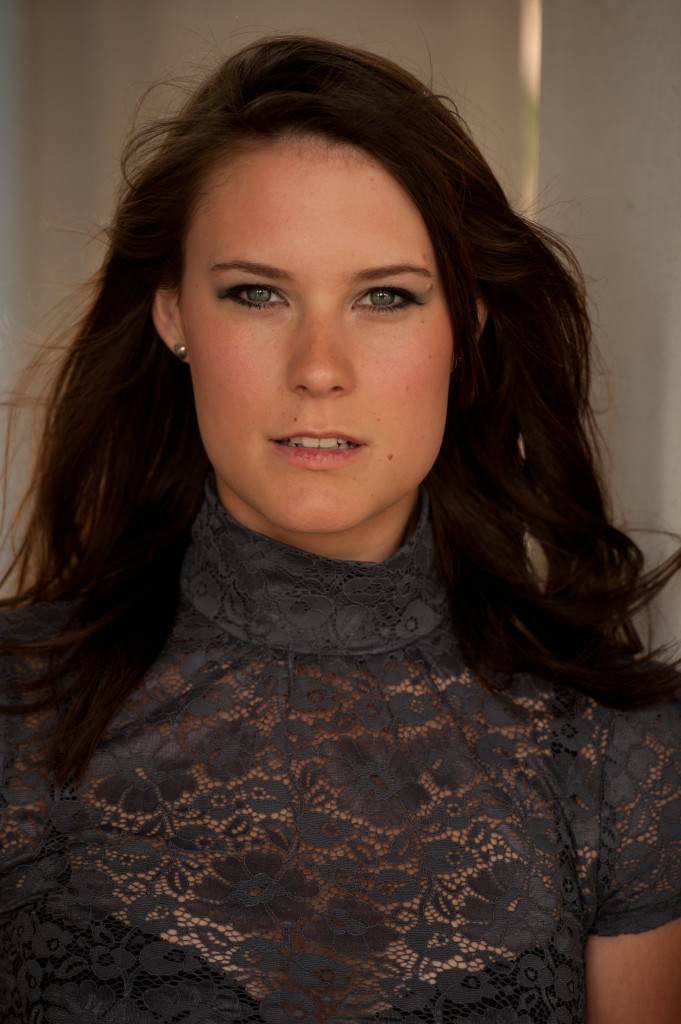3. What is the hardest part about dance for you?
Dance: The Power Of Pauses
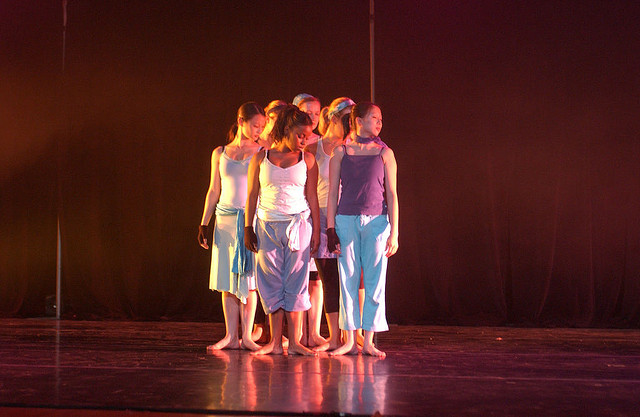
by Karen Musey
There is always one thing I’d love to tell dancers while watching competition pieces:
Pauses are powerful. Could you find more in your piece?
Judges watch 2 + minutes of choreography that is often packed to the brim. Feeling the crunch to “fit everything in” and their adrenaline pushing them forward, the dancer is only able to half-finish a movement in order to get to the next in time.
I know dancers want to demonstrate as much as they can and choreographers want to give their dancers challenges they can grow into. I absolutely support you in wanting to grow and be your best self.
But how do pauses affect a piece of choreography’s impact on an audience?
Pauses in choreography allow for the dancer’s expression in a piece to change and evolve. If there are no changes in energy, the choreography can become indecipherable like a run-on sentence: the dancer and audience hold their breath and everyone wonders why they are exhausted after.
Audiences notice the dancer’s interpretation of the peaks and the valleys of the choreography. They feel the inhales and the exhales. They react to the energy dynamic of a go or a stop. The emotional quality and thoughts behind a comma, the excitement of an exclamation mark! The stillness of a period.
To hold space onstage with stillness requires vulnerability. It feels very powerful and creates anticipation. Being onstage with “nothing to do” can feel overly revealing. I will tell you though –
Every piece I’ve watched that won top awards had the dancer(s) commanding powerful pauses in their choreography.
What can you do to find and craft the pauses?
Understand The Intention Behind Your Choreography.
This is an important step whether you are in the process of picking your music, are in the midst of creation, or while perfecting the choreography.
Why was this particular piece of music or theme chosen? Is there an intention to explore a topic, a way of moving, a way of expression? How do you personally relate to the song/theme and how can you grow from it?
What if it is a foreign way of moving, expression or style that you do not yet relate to?
Will taking extra classes help you acquire a clearer competency of the style? Could watching current events or movies that relate to your subject matter give you a better comprehension of the idea? Could you discuss with your teacher/choreographer and peers how you can interpret a more truthful and revealing expression of the piece?
When you relate to and understand the intention behind your choreography, you will be able to break it down and find dynamic through pauses.
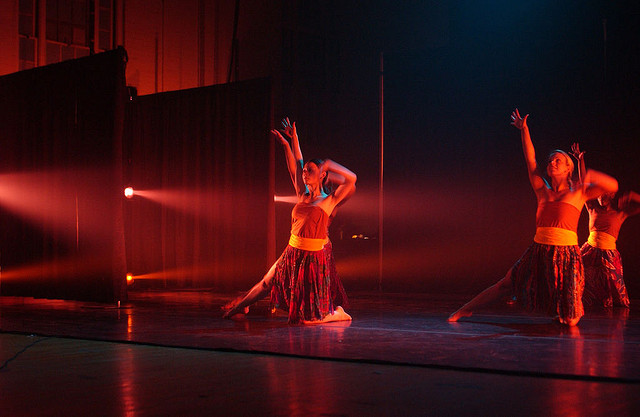
snickclunk. Licensed under CC Attribution 2.0 Generic.
Get Comfortable With Stillness.
Improv is a great way to experiment with pauses. If you improv and can find places to be still, discovering and owning the pauses in your own choreography will be easy and fun!
Choose different pieces of music to improv to that have varied types of pauses. Some may be static and sharp; others might be subtle or lengthy. Having your teacher create artificial pauses by hitting pause while playing the music can also accomplish this (similar to freeze dance, but for improv!). Allow yourself to relax and breathe in whatever shape you have created – feel the architecture of the shape and be open and curious to what thought or expression that shape could be endowed with.
The more you explore different types of pauses, the more you will become creatively curious in how you shape them in your choreography.
Nervous Tension vs Powerfully Creating Space.
What is the difference between tensely holding a pose or feeling the shape of it and breathing into the space around you?
Sometimes tension in poses is beneficial and creates a certain feeling in the piece; other times it stops breath, creates anxiety and uproots the dancer from their connection with the floor. If a dancer tensely holds a pose without breathing and with nervous energy, they often have difficulty easing into the next part of the choreography and have to play catch up.
Knowing exactly how many counts your pause is and how you can continually fill and shape it with energy and breath will keep you grounded, focused and in command of your choreography.
Slow Down.
What if you are already working on a set piece and it is choreographically dense without discernible pauses? Yay! What a great challenge for you.
First, slow your music down to a speed that you can easily complete the steps with. The slower, the better. You can use Garageband or other music programs to quickly adapt the speed of your music. If you articulate your movement at a more workable pace, you will start to notice all the different types of little pauses that can be found in between each phrase of movement.
Then – when you are able to fully commit to and finish your movement with the phrasing in place, you can gradually start to quicken the tempo. You will have developed the coordination and clarity you need for a more defined, polished piece of choreography. The pauses, phrasing and artistry of the piece will be intact, leaving you feeling powerful about the interpretation you want to showcase.
~~~
By taking the time to investigate your choreography early on, you will create the possibility for fantastic performing opportunities down the road. Enjoy the journey
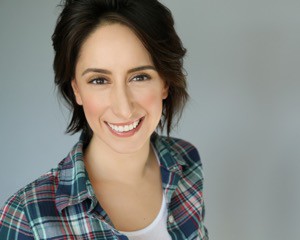
Contributor Karen Musey is a dynamic Canadian born, New York based performer,teacher and dance adjudicator. Her training includes study at Canada’s Royal Winnipeg Ballet Professional Division, The Banff Centre, EDGE PAC (LA), Upright Citizen’s Brigade, The Barrow Group, Kimball Studio, Canada’s National Voice Intensive, Comic Strip Live and more.
Karen Musey judges national and regional dance competitions and festivals across the United States and Canada. She was a Director/Choreographer Observership Candidate during the 2011/12 season with Stage Directors and Choreographers Union and has served as a rehearsal director and dance captain for KOBA Family Entertainment. Karen Musey is an ABT® Certified Teacher, who has successfully completed the ABT® Teacher Training Intensive in Pre-Primary through Level 5 of the ABT® National Training Curriculum. She is a U.S. Member of the International Dance Council CID, recognized by UNESCO.
Performing highlights – PHISH at Madison Square Garden; World Premiere of the Canadian Opera Company’s Das Rheingold (Wagner Ring Cycle); National Artist Program Gala for the 2003 Canada Winter Games; for HRH Queen Elizabeth II during the Golden Jubliee Tour; Chicago (Rainbow Stage); comedy short Foreign Exchange (72 Hour Asian American Film Shootout); music videos for The Guards and Malynda Hale; international tours and performances with The Young Americans, J.A.R. Productions and KOBA Family Entertainment; stand up and sketch comedy around New York; Bravo! documentaries, films and more. She is currently co-writing a play. www.karenmusey.com
Dancing In The Land Of Sweets
This year marks my 16th Nutcracker season. I have had the privilege of performing seven of those seasons in George Balanchine’s version of the Nutcracker, which premiered in 1954 in New York City.
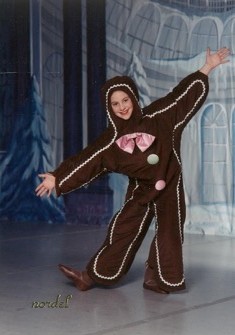
It is common for The Nutcracker to be the first performing opportunity dancers have in their pre-professional career. Once training intensifies, the requirements for Nutcracker can become more demanding. My first Nutcracker experience was with the Northeast Youth Ballet under the direction of Denise Cecere. With the Northeast Youth Ballet, I spent six seasons performing most of the roles in the ballet including Clara and the Dew Drop Fairy. The last couple years of my training were spent performing in Boston Ballet’s Nutcracker under the direction of Mikko Nissinen. Performances with the Northeast Youth Ballet and Boston Ballet were crucial to my understanding of future professional life.
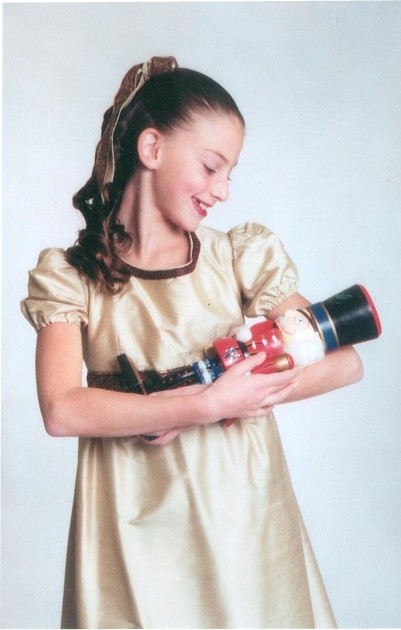
In 2009, I was first exposed to George Balanchine’s The Nutcracker with Alabama Ballet. During my five seasons with the company, I was given opportunities to perform many roles including the Sugar Plum Fairy, Arabian, and Lead Marzipan. One particular role I fell in love with was Coffee, also known as Arabian. I was chosen to perform Coffee for all five seasons. This repetition gave me time to refine this specific role while also exploring the other personalities that make the ballet unique.

At Miami City Ballet, rehearsals for George Balanchine’s The Nutcracker begin in September. It is a special time of year in which you hope to gain new experiences and bring something different to your audience. Performances span from the beginning of December until New Year’s Eve. This will be my fourth season performing as the Sugar Plum Fairy and my second with Miami City Ballet. Along with performing the Sugar Plum Fairy, I will performing the roles of Lead Spanish, Demi-Soloist Flower, Marzipan, Flower, Snow, and Party Parent.
As a little girl I had always dreamed of dancing as the Sugar Plum Fairy. Last season, when I saw my name on the casting list to dance the iconic role, I couldn’t wait to get to work. It was a new opportunity to perform a very rewarding and challenging role in a new home. On top of that, I was paired with a partner, Ariel Rose, who I had spent time dancing with in Balanchine’s Who Cares? at Boston Ballet. It has been really special to work with Lourdes Lopez on this principal role. The time Ariel and I have spent with Lourdes and Arnold and Joan Quintane this season has allowed us to bring our own interpretation to the dance.
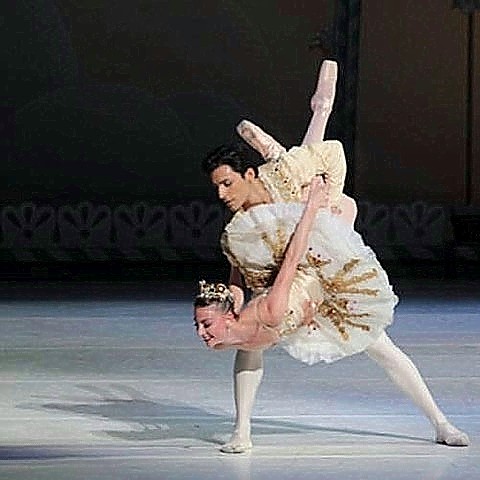
In George Balanchine’s The Nutcracker, the Sugar Plum Fairy holds a large amount of responsibility. She is the first and last Sweet to perform in Act II and is responsible for showing Marie and the Prince their way. When I revisit classic roles like the Sugar Plum Fairy I hope to show audiences what I’ve been working during the rest of the season.
Personal and professional lives are usually combined during Nutcracker season. It can be difficult to spend time with family and friends because of performances and rehearsals. We perform five to six times a week while also preparing for our second repertory program. Fortunately, my family usually comes to visit and see some of the performances. During my time off I like to read, write, or watch old TV shows like Friends on Netflix. Having an outlet allows me to reset and rest my brain from ballet.
Miami City Ballet will be performing George Balanchine’s The Nutcracker December 5-7 in Naples, FL, December 11-13 in Fort Lauderdale, December 17-24 in Miami, and December 27-29 in West Palm Beach.

Contributor Samantha Hope Galler, a Bedford, Mass. native, spent 13 years training with The Ballet Academy, Inc., under the direction of Frances Kotelly in the Cecchetti Method. She performed six seasons with The Northeast Youth Ballet under the direction of Denise Cecere. She continued training, on scholarship, with Boston Ballet School and received the PAO Merit Trainee Scholarship. She received the NFAA Honorable Mention Award in Ballet. Galler spent summers training at Boston Ballet, Central Pennsylvania Youth Ballet and Boston Conservatory. She danced with Cincinnati Ballet in their 2008-2009 season under the direction of Victoria Morgan.
Samantha spent five seasons with Alabama Ballet under the direction of Tracey Alvey and Roger Van Fleteren. During her tenure there, she was promoted to principal dancer. She had the honor of performing some of her dream roles including Juliet in Romeo and Juliet, Odette/Odile in Swan Lake, The Lilac Fairy in The Sleeping Beauty, The Sylph and Effie in La Sylphide, Myrtha and Moyna in Giselle, Dryad Queen and Mercedes in Don Quixote, the Rancher’s Daughter in Agnes De Mille’s Rodeo. Her Balanchine roles included Dark Angel in Serenade; The Sugarplum Fairy, Arabian and Lead Marzipan in George Balanchine’s The Nutcracker™; and the principal roles in Allegro Brillante and Tarantella. She has also performed in Jiří Kylian’s Sechs Tanze, and Van Fleteren’s Shostakovich and Romancing Rachmaninov, both world premieres.
Samantha joined Miami City Ballet as a member of the corps de ballet in 2014. Since joining Miami City Ballet, Samantha has performed in various roles including as the Sugar Plum Fairy in Balanchine’s The Nutcracker and as the Harp Soloist in Balanchine’s Raymonda Variations.
Preview: Atlanta Ballet’s Nutcracker

This year’s Nutcracker season is both an exciting and bittersweet time for Atlanta Ballet. It marks the 20th anniversary of artistic director John McFall’s version of the beloved holiday classic as well as his final Nutcracker with the company. After leading Atlanta Ballet since 1994, he will retire at the end of the 2015-2016 season.
Atlanta Ballet’s Nutcracker, which runs from December 11-27, will be performed at the historic Fox Theatre and accompanied by the Atlanta Ballet Orchestra led by principal guest conductor Gary Sheldon. The Georgia Youth Choir will sing during Act I’s Snow Scene
Atlanta Ballet’s Alessa Rogers, now in her ninth year performing as Marya (the production’s Clara/Marie equivalent) began portraying the part as a student. A couple of years later, McFall decided to change Marya into a role for a company dancer. “I think when he choreographed the updated Marya, he definitely considered his own feisty young daughters,” says Rogers, “He also took a lot of input from company dancers who were performing the role. We all bounced ideas off of one another. Atlanta Ballet has a very open and collaborative environment so we really molded the role together. But each Marya retains the right to tweak things and interpret the part in the way that makes the most sense to her.”
In McFall’s Nutcracker, Marya plays a more active role up than she does in other interpretations. “She has a lot more to do than stand around and open presents,” explains Rogers, “In the first act she has a bit of a flirtation with Drosselmeyer’s nephew. At the end of the battle scene, she takes the initiative to defeat the Rat King using a sword she steals from a rat.”
In that climatic scene, the Rat King’s costume increases his height to a towering eight feet and the Nutcracker wears a two-pound mask as he combats against him. “Dancing with the giant sword isn’t easy with a lot of people on stage,” says Miguel Montoya, who is debuting as the title character this year, “But those moments are still fun parts that make the scene more interesting and the role more challenging in a good way.”
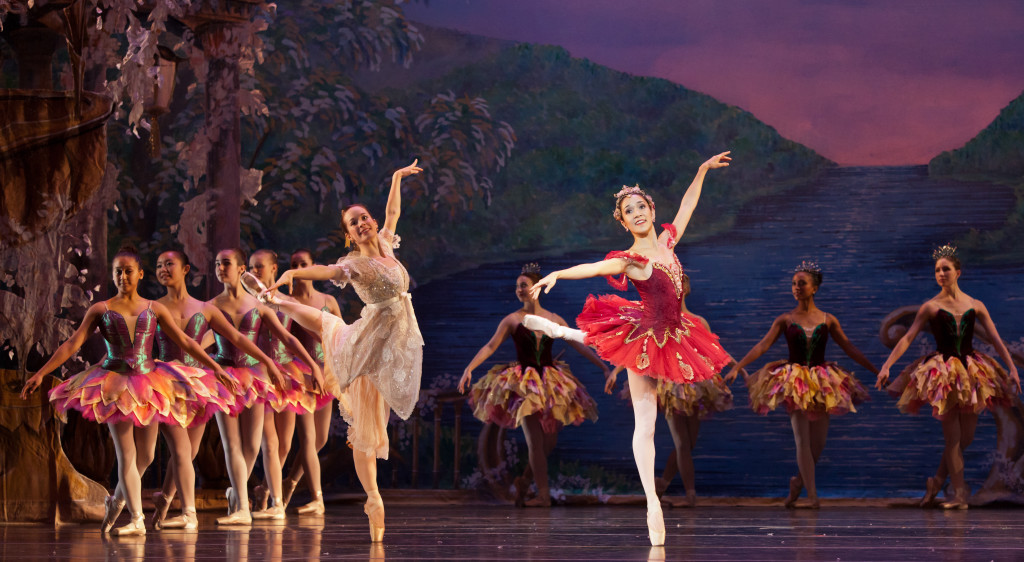
Also making a role debut this year is Yoomi Kim, who will be dancing the Sugar Plum Fairy. “This has been my dream role since I was a little kid,” she says, “I used to watch The Nutcracker with my parents during the Christmas season and I was fascinated by the magical Sugar Plum’s kingdom. Ever since I started dancing the role, my love for Sugar Plum has grown deeper.”
In Atlanta Ballet’s Nutcracker, the Sugar Plum Fairy dons an unconventional burgundy tutu and shares her iconic solo with Marya. “Sugar Plum is like a role model to Marya and that is illustrated through the choreography,” says Kim, “Each movement of the variation is mirrored by Marya, which makes for a very beautiful and special moment on stage between the two characters.”
The choreography for the variation of the Prince, the Sugar Plum Fairy’s dance partner, also has a unique twist in Atlanta Ballet’s version. “McFall grants us permission to make our own variation,” says Jacob Bush, who has been dancing the role of the Prince for six years, “You can challenge yourself. It’s fun!”
As with any production that’s presented annually, The Nutcracker offers its performers new challenges and opportunities for growth. How do dancers build upon roles they’ve revisited for many Nutcracker seasons? Bush focuses on enhancing movement quality and artistry. “I have been dancing with the same Sugar Plum Fairy, Tara Lee, for a while now,” he says, “Each year, we talk a lot about how we can finesse the movement so we are as calm as possible. I think that gives it the regal look we both want the characters to have.” For Rogers, it’s about dramatic content and recreating seasonal enchantment. “The challenge of doing any role for nearly a decade is keeping the interactions spontaneous,” she says, “Especially because Marya is a young girl, I have to remember the feeling of Christmas morning when I was a child–that effervescence, that joy and exuberance and sparkle. But Marya is such a joy-filled character and performing for those people in the audience who have never seen a ballet before–that is a magic that keeps me motivated.”
Tickets start at $25.00. Purchase here.
https://www.youtube.com/watch?v=4Ysb2elWK2E
Dancer Profile: Justin Peck
https://instagram.com/p/zkXwa3qRUr/?taken-by=justin_peck
(Peck, front right, in his own work Rōdē,ō: Four Dance Episodes)
“There’s this Diaghilev quote that I always go back to. It’s very simple. He said, “I have big plans.” Maybe I’m being overly optimistic. But that’s how I feel. ” – Justin Peck
At age 13, Justin Peck was cast as in extra in American Ballet Theatre’s touring production of Giselle. Witnessing the athleticism of ABT’s male dancers Herman Cornejo, Marcelo Gomes, and Ethan Stiefel inspired him to begin ballet training. Previously, he had only taken classes in tap and musical theater. He found ballet challenging, particularly extension and turnout. Nonetheless, within just two years, he proved proficient enough to be accepted into the School of American Ballet. He became an apprentice with New York City Ballet in 2006, a corps member in 2007, and a soloist in 2013.
Peck’s career took a unique turn when he decided to take a dance criticism course at Columbia University. There, his professor Mindy Anloff told him he had a good mind for choreography and encouraged him to give it try. Peck’s first work was a pas de deux for the student-run company Columbia Ballet Collaborative. From there he went on to New York City Ballet’s affiliated program The New York Choreographic Institute. His creations caught the eye of NYCB’s artistic director Peter Martins who invited him to choreograph for the company.
In 2014, after choreographing for New York City Ballet for only two years, Peck was named New York City Ballet’s Resident Choreographer. He was just 26 at the time. New York Times dance critic Alastair Macaulay has written that Peck is “the third important choreographer to have emerged in classical ballet this century, following Christopher Wheeldon and [Alexei] Ratmansky.”
In Peck’s choreographic process, music and collaboration have priority. He told the Washington Post,”My philosophy on choreography is that the making of a ballet is a team effort, and we’re in this together. It’s not me hammering on them. It’s more about how we can elevate this piece collectively to something great.”
Fun Facts:
- Peck’s role in ABT’s Giselle at age 13 was a dog handler in Act I
- His guilty food pleasure is Australian licorice
- He admits the main reason he wanted to attend SAB was to live in New York City; he didn’t actually know much about Balanchine when he applied.
Follow Peck On:
His website: http://www.justin-peck.com/
Twitter: https://twitter.com/justin_peck
Instagram: https://instagram.com/justin_peck/
Facebook: https://www.facebook.com/justinisjustinpeck
YouTube: https://www.youtube.com/channel/UCcALX4g97mMXFZtBRSHBv0Q
Vimeo: https://vimeo.com/justinpeck/videos
Justin Peck and Janie Taylor
Justin Peck and Taylor Stanley on Peck’s ‘Rōdē,ō: Four Dance Episodes
https://www.youtube.com/watch?v=KqPDiyXjTbc&feature=youtu.be
Justin Peck & Sufjan Stevens – Excerpts and discussion of Peck’s “Year of the Rabbit”
Miami City Ballet: Justin Peck & Shepard Fairey – Excerpts and discussion of Peck’s “Year of the Rabbit”
Articles [Read more…]
- « Previous Page
- 1
- …
- 7
- 8
- 9
- 10
- 11
- …
- 21
- Next Page »





